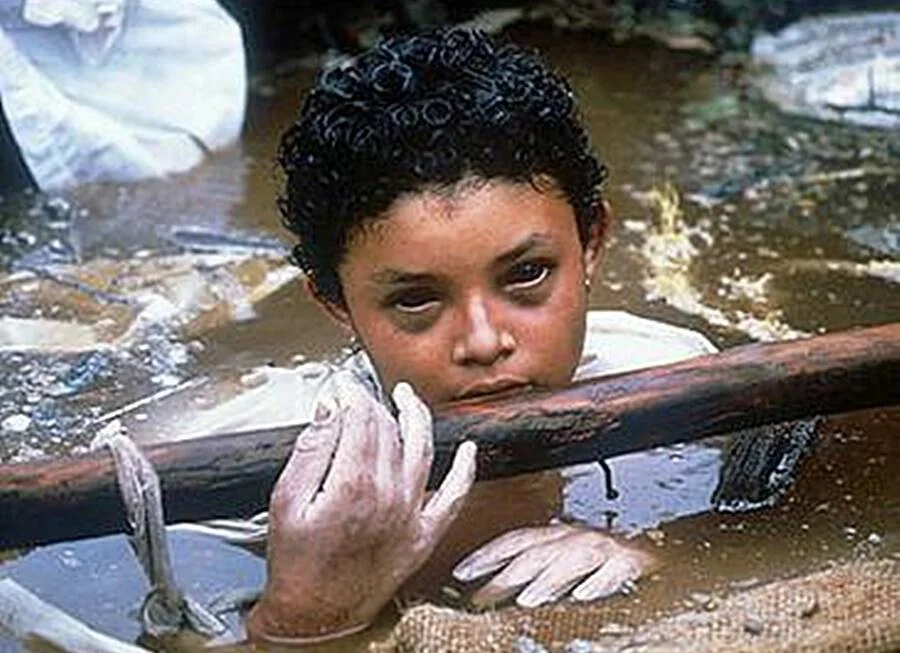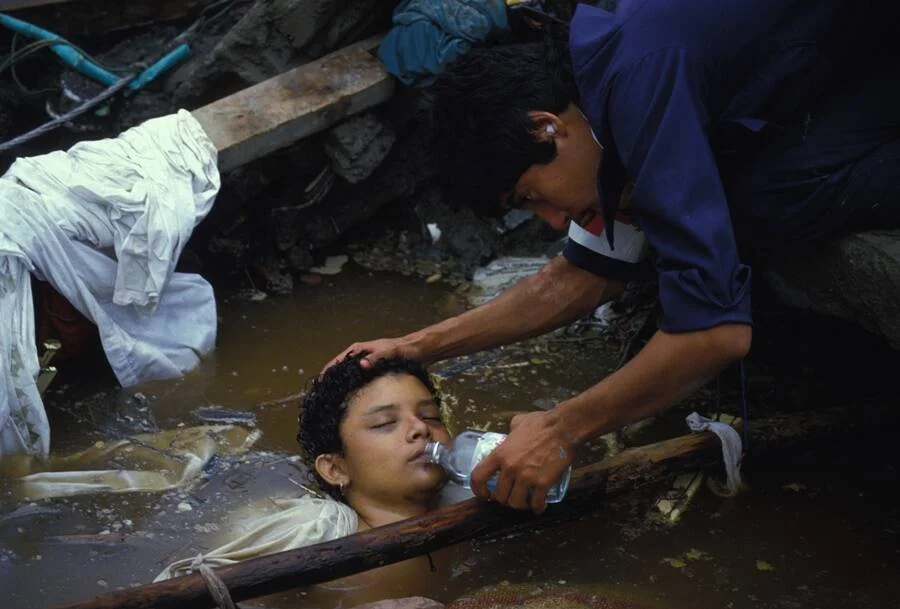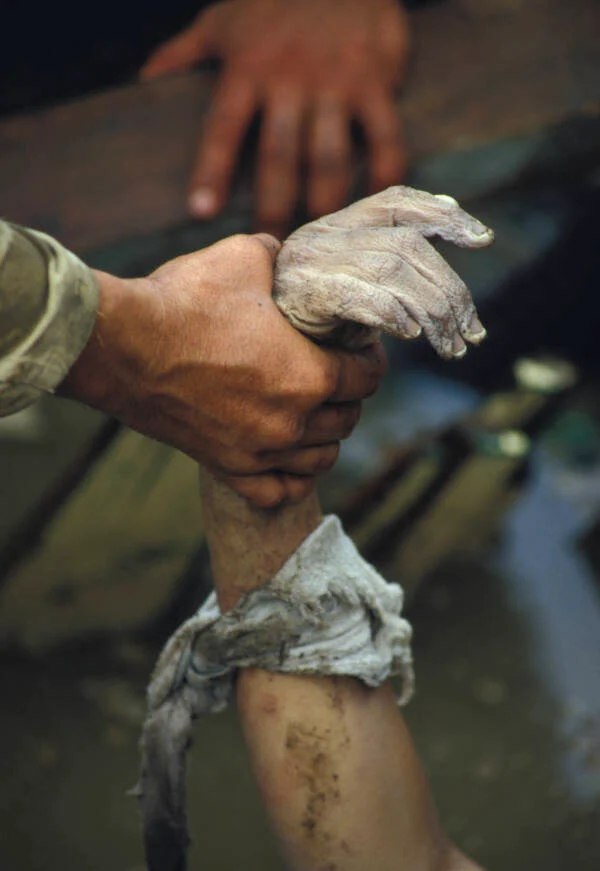On the night of November 13, 1985, a catastrophic volcanic eruption in Colombia unleashed a tragedy that would etch one name into the world’s collective memory: Omayra Sánchez. For sixty harrowing hours, the 13-year-old girl was trapped in mud, debris, and rising water, while the eyes of the world turned toward her suffering. Her final moments became not only a symbol of human fragility but also a haunting reminder of governmental inaction, unpreparedness, and the raw face of disaster.

The Night Armero Fell
It began with the eruption of the Nevado del Ruiz volcano, located in the Andes mountains of Colombia. For months, volcanologists had warned of danger. Ice caps atop the volcano could melt, triggering deadly lahars—fast-moving avalanches of mud, rock, and water. But the warnings went largely unheeded.
At 9:09 p.m., the inevitable occurred. Pyroclastic flows melted the mountain’s ice, sending torrents of mud roaring down valleys at speeds of up to 40 kilometers per hour. Within hours, the town of Armero, located nearly 50 kilometers away, was buried beneath meters of debris. More than 20,000 people died. Thousands more were injured or displaced.
In the midst of this devastation, one image captured the attention of the world: a young girl named Omayra, pinned waist-deep in a watery grave.
Trapped Beneath the Ruins
Omayra had been at home when the lahar struck, demolishing her house and burying her family. Her father was killed instantly. She and her aunt were trapped beneath the rubble, with Omayra’s legs pinned under a collapsed roof and tangled debris.
Rescuers soon located her, but freeing her proved nearly impossible. The water level around her rose steadily, and any attempt to pull her out risked breaking her bones or causing fatal injury. To save her, heavy equipment and specialized pumps were required—equipment that never arrived in time.
And so, for three days, the world watched as a child fought for her life.

The Human Face of Disaster
Journalists, photographers, and television crews who reached the site transformed Omayra’s struggle into an international story. The most famous image—taken by French photojournalist Frank Fournier—showed her face, pale and exhausted, eyes wide with despair yet still carrying a haunting calm. That photograph would go on to win the 1986 World Press Photo of the Year, but it also ignited fierce debate about the role of media in human suffering.
Throughout her ordeal, Omayra displayed remarkable courage. Witnesses recalled her speaking softly to rescuers, asking for food and water, and even singing to herself. At times, she spoke of school, friends, and her dreams of becoming a singer. Her resilience astonished even seasoned reporters.
But her condition worsened with each hour. Blood circulation in her legs collapsed, hypothermia set in, and her eyes grew swollen. Still, she clung to life, waiting for help that never came.
A Global Audience, A National Shame
The Colombian government’s response to the Armero tragedy was widely criticized as slow, chaotic, and insufficient. Relief efforts were disorganized, with aid blocked by poor infrastructure, communication failures, and bureaucratic delays. For Omayra, these systemic failures translated into abandonment.
International viewers watched the footage with horror. Television networks broadcast her plight live, sparking outrage and empathy. Donations poured into Colombia from around the globe, but on the ground, equipment shortages and logistical confusion meant little could be done for her.
As one rescuer told reporters: “We had the will, but not the tools. She needed machinery, and we had nothing.”

The Final Hours
By the third day, Omayra’s strength was fading. Her once-clear voice grew faint. At times, she hallucinated, speaking to her late father and imagining herself back at school. Rescuers tried to comfort her, bringing her sweets and talking to her as if she would soon be free.
But she knew the truth. In her final words, she reportedly whispered: “Mom, if you’re listening, I love you. And goodbye.”
On November 16, after 60 hours of suffering, Omayra Sánchez died. Her body was eventually recovered, but her story had already become immortal.
The Image That Shocked the World
Fournier’s photograph of Omayra—her face framed by mud, exhaustion, and quiet acceptance—was published in newspapers worldwide. To many, it was unbearable to look at, a visual reminder of government negligence and the human cost of unpreparedness.
Some criticized the photographer for intruding on such an intimate moment of suffering, but Fournier defended his work: “I felt the story had to be told. I wanted the world to know what was happening. She was incredibly brave. I had to show her dignity.”
The image became one of the most iconic disaster photographs of the 20th century, often cited alongside images of famine, war, and catastrophe as a symbol of human resilience amid neglect.
Legacy and Lessons Unlearned
The tragedy of Omayra Sánchez raised pressing questions about disaster preparedness in Colombia and beyond. Despite warnings from scientists, the government had failed to evacuate vulnerable towns like Armero. The price of inaction was tens of thousands of lives.
In the years since, Colombia has made strides in monitoring volcanic activity and disaster response, but critics argue that poverty, corruption, and neglect still leave communities vulnerable. The name Omayra remains a painful reminder of what happens when warnings are ignored.
Internationally, her story has been taught in schools, referenced in humanitarian campaigns, and immortalized in documentaries. For many, Omayra embodies both innocence and injustice: a child whose final hours were lived in dignity, yet whose death was avoidable.
Remembering Omayra
Nearly four decades later, Omayra Sánchez is remembered not only as a victim but as a symbol of courage. Annual memorials in Colombia honor her life, while her photograph continues to stir emotions across generations.
To her mother, who survived the tragedy, Omayra remains a guiding spirit. “She was strong until the end,” she once said. “She showed the world her bravery. I wish the government had shown the same.”
Conclusion: A Haunting Echo
The story of Omayra Sánchez is not simply about a young girl lost in a natural disaster. It is about neglect, humanity, and the cost of inaction. For 60 hours, the world bore witness to a child trapped between hope and despair, resilience and helplessness.
Her watery grave in the ruins of Armero remains one of the darkest chapters in Colombia’s history. But Omayra’s spirit lives on—not just in photographs and headlines, but in the urgent reminder that no warning should ever be ignored, and no child should ever die waiting for help that never arrives.



